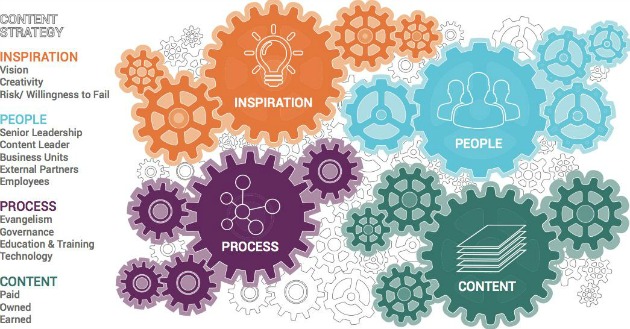
Content. It’s not just for the marketing department anymore. These last few months I’ve been researching how organizations are forming, and benefitting from, what my co-author Jessica Groopman and I are terming a “Culture of Content.” Our findings have just been published in this report.
What’s a culture of content? Here’s our definition:
A culture of content exists when the importance of content is evangelized enterprise-wide, content is shared and made accessible, creation and creativity are encouraged, and content flows up and downstream, as well as across various divisions. A formalized yet not immutable content strategy is the framework upon which to base culture.
In other words, content is becoming nearly everyone’s job — and with good reason. Not everyone in marketing is a subject matter expert. Or understanding customer service or sales concerns. Or recruiting new employees. Or developing new product features. That expertise and knowledge is embedded deep within the enterprise. Organizations that foster a culture of content can better ideate and create useful, meaningful content at scale that addresses numerous goals and serves a wide variety of internal, and well as external, constituencies.
Our research covers many aspects of the culture of content, perhaps none more important than its anatomy. We identified four foundational elements upon which content culture is based.
Vision
Establishing a common vision is a critical first step to developing a content strategy and is typically most effective when generated, embodied, and exemplified by senior leadership — this is ideally both the C-suite, as well as a content leader or champion. Disseminating vision from the top down helps employees understand how their day-to-day tasks serve a higher purpose and align with organizational and even social or humanitarian goals.
Creativity
A drive to think beyond content as “just” marketing inspires a Culture of Content. Training across the organization to creatively think about and produce content serves two ends. First, it helps differentiate the organization through its content, an increasingly important tactic in a crowded and noisy media environment. Second, it grants the individuals who create content as part of their jobs (e.g., designers, copywriters, bloggers, videographers) freedom to flex their creative muscles to reach current and new audiences.
Creativity flourishes with multiple perspectives. Customers and employees alike can serve as an inspirational source for creative content. Content marketers (among other business functions) can leverage both earned media and listening analytics across all media to extract insights on how to evolve existing artifacts and justify new approaches.
Risk — and a willingness to fail
Risk coupled with a willingness to fail repeatedly emerged in our research interviews as a critical force for empowering a culture of content. Assurance and permission to fail mitigates fears such as fear of failure, embarrassment, and job termination, all fundamental obstacles to the creative process. Strong content is valuable — it informs, educates, entertains, or solves a problem. To differentiate through any one of these uses, content marketers must be able to, comfortable with, and empowered to take risks, to fail entirely, and to move on, all the while applying learnings from failure.
This post originally published on iMedia
